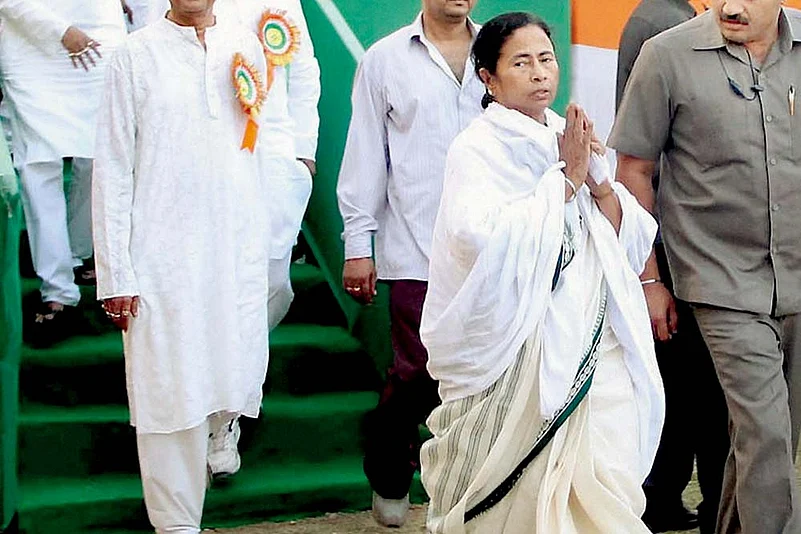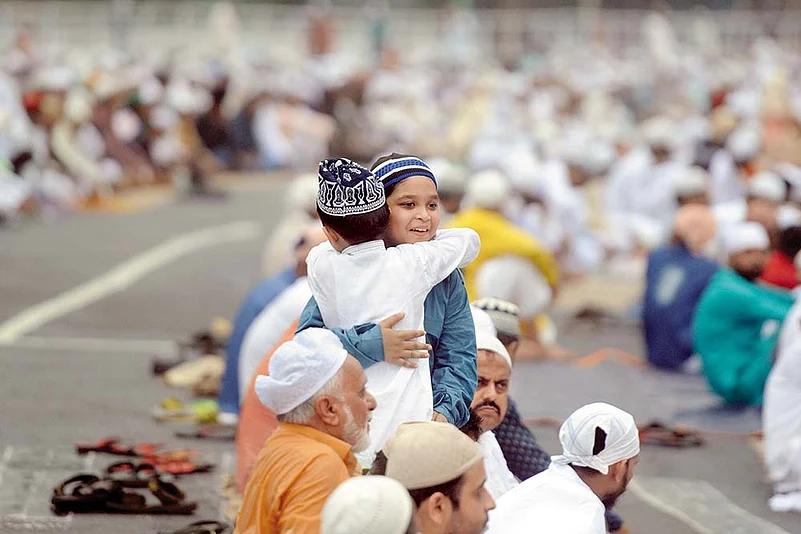On November 13, three days after the Bihar election results, Imran Solanki sounded upbeat while speaking over the phone from Calcutta’s NSC Bose airport, waiting to catch a flight to Hyderabad where he and his companion, Syed Dilawar Hussain, were to meet the central leadership of the Asaduddin Owaisi-led All India Majlis Ittehad e Muslimeen (AIMIM). Solanki has been one of the prime organisers of the AIMIM in West Bengal, though Owaisi is yet to formally launch his party here.
“We hope announcement of the launch of our party should happen very soon. We expect to get a clear idea about our Bengal project during our meetings in Hyderabad,” says Solanki. Syed Asim Qaqar, the AIMIM’s national spokesperson and Bengal in-charge, also expects the launch “very soon”. As AIMIM national president Owaisi had said recently, “We’ll fight in Bengal with all our might.”
ALSO READ: Capped Crusader
Solanki is upbeat about a new party’s prospect in a state going for the elections in less than six months because of geography and “a political vacuum”. As per the 2011 census, Muslims comprise 27.01 per cent of West Bengal’s population, and they play a significant role in determining the winner in about 70 assembly seats.
“We have our leadership identified in most districts. Most importantly, four of our five seats in Bihar come from Purnia and Kishanganj districts, both of which share borders with Bengal’s Muslim-majority districts,” Solanki says.
Owaisi’s Bengal plan is part of the party’s eastern India strategy, focusing on the tri-junction of Bengal, Bihar and Jharkhand. This region, comprising the contiguous districts of Pakur and Sahibganj in northeastern Jharkhand, Purnia, Araria and Kishanganj in northeastern Bihar, and Uttar Dinajpur, Malda, Murshidabad and Birbhum districts in northern and central Bengal, has the thickest Muslim population in eastern India. These nine districts have a population of 27,419,767 (census 2011), and 50.63 per cent of them are Muslims. “The party started work in the tri-junction after identifying it as a strategic region in 2014,” says an AIMIM organiser in Bengal.

Mamata Banerjee in Lalbagh in Murshidabad, a former Congress bastion now eyed by AIMIM.
The first steps were taken in Bihar, where the party fielded six candidates in the 2015 assembly polls, but failed to make a mark. In 2019, success came in the form of winning Bihar’s Kishanganj assembly bypoll, but that same year AIMIM drew a blank in the Jharkhand assembly election. In 2020 in Bihar, they lost Kishanganj but gained five new seats. Of the seats AIMIM won in Bihar, Kochadhaman, Amour, Baisi, Bahadurganj shares borders with Goalpokhar, Karandighi, Chakulia and Islampur assembly constituencies in Bengal’s Uttar Dinajpur district.
ALSO READ: Look Back In Denial
Of the four Bengal districts along the Bihar and Jharkhand border, Murshidabad has 66.27 per cent Muslim population, while for Malda, Uttar Dinajpur and Birbhum the population share is 51.27 per cent, 49.92 per cent and 37.06 per cent respectively. These four districts have 54 of the state’s 294 assembly seats and the ruling Trinamool Congress (TMC) is heavily banking on a sweep of this belt. Besides, Calcutta’s neighbouring districts of North and South 24-Parganas have a sizable Muslim population.
Sensing competition, from 2019, Mamata Banerjee has taken several digs at the AIMIM without naming it, terming it “outsider”, “instigators” and “the BJP’s B-team”.
One of AIMIM’s Bengal organisers says the party was “highly likely” to contest in a select number of seats. “It could be three to four dozens,” he says. While the likes of Solanki may be upbeat, the ground reality for the AIMIM isn’t propitious. While trying to lay a foundation for years, the AIMIM has faced repeated impediments, with workers either quitting or being inactive. A former AIMIM organiser blamed the central leadership of indecision on Bengal. The party revived its activities in Bengal after the 2019 Lok Sabha polls, especially during the anti-CAA protests, but faced a setback when several leading organisers landed in jail in connection with a series of police cases during December-January 2019-20. The Covid lockdown further hampered their work.
ALSO READ: Middle Name Confidence
“I have remained inactive over the past few months. There is the police to deal with, while the party’s leadership showed no commitment towards Bengal. It was getting risky,” says a key AIMIM organiser in Cooch Behar district. Another state-level organiser, Anwar Pasha, spent 50 days in police custody at seven police stations in East Midnapore district in December and January in connection with cases of violence and arson during the anti-CAA protests. “At present, I am neutral. I think preventing the BJP from winning Bengal should be the top priority of every secular person,” says Pasha, who has not been active since his release.
Among other senior organisers who were jailed are Zameerul Hassan, Arisan Sultan and Murshid Ahmed of Calcutta, S.K. Salim of Ghutiyari Sharif in South 24-Parganas, Asadul Sheikh and A.K. Hannan of Jangipur in Murshidabad and Motiyur Rahman of Malda. Motiur was arrested for writing an objectionable Facebook post on chief minister Mamata Banerjee, while Asadul, Hannan and their associate Golam Ambia were arrested on charges of assaulting a TMC leader and intimidating people into joining the AIMIM. Mohammad Safiullah Khan and Zameerul were arrested for alleged involvement in a violent anti-CAA protest. Sensing trouble, Imran Solanki fled the state in December 2019 and remained in Hyderabad till February 2020, returning after obtaining bail from the Calcutta High Court.
ALSO READ: Make Space For Three
Some of these arrested organisers, who spent between one to seven weeks in jail, returned to gradual political work after lockdown rules were relaxed in August-September. They include Asadul, a leading organiser in Murshidabad, the district with India’s highest Muslim population—4.7 million. It has 22 assembly seats, the highest for any district in Bengal.
Asadul says the Bihar results come at the right time for their activities to gain momentum, claiming that 50 youth Congress workers joined the AIMIM on November 14, followed by a similar number the following day. These, he says, are examples of how the AIMIM is gaining strength in numbers at the grassroots level. “If Didi has to win in 2021, she must strike an alliance with us,” he says.

The AIMIM’s Bengal observers admit that after finding it difficult to get Trinamool supporters to change sides, they are targeting Congress supporters. The Congress still has a support base in the Muslim-majority Murshidabad and Malda districts—once their impregnable bastion, now largely lost to the TMC—where AIMIM is targeting grassroots level Congressmen. The Congress’s Lok Sabha leader and Bengal Congress president Adhir Ranjan Chowdhury is a five-time MP from Berhampore in Murshidabad, while the TMC holds the two other LS seats.
According to political analyst Maidul Islam, Owaisi’s party would face two major challenges. One is that a majority of Bengal’s Muslim voters appear to have consolidated behind the TMC; the other is a language disconnect. “AIMIM’s top leaders speak a mix of Urdu and Hindi, which Bihar’s Muslims can connect with. But in Bengal, the overwhelming majority of Muslims are Bengali-speaking. The AIMIM will find it difficult to create a connect until it has grown a Bengali-speaking leadership,” says Islam.
Islam argues that in Bihar, the AIMIM developed its base over the past five years, whereas in Bengal it is still haphazard. Besides, according to him, due to the Trinamool regime’s implementation of the Ranganath Mishra Commission’s recommendation of including Muslims in the Other Backward Classes (OBC) category, there has been an improvement in the socio-economic standards of the state’s Muslim population. “The AIMIM has managed to create a support base among the Muslim middle class, especially teachers of schools, colleges, universities and madrasas, but they have no base among the peasantry. However, the AIMIM has proved that it can play a spoiler for secular parties and in Bengal, too, they can do it in a few seats,” says Islam.
Siddiqullah Chowdhury, Jamiat Ulama-e-Hind’s Bengal unit president and a TMC minister, says the AIMIM has no prospect in Bengal. “They may try to create advantageous situations for the BJP but Muslims have no reason to turn away from Mamata Banerjee,” Chowdhury says. A TMC Lok Sabha MP, however, expresses concerns that even if the AIMIM fails to split votes, divisive speeches by AIMIM leaders could help the BJP’s polarisation plan.
In the 2019 Lok Sabha elections, the TMC won 22 of the state’s 42 seats with a 43 per cent share of the polled votes, whereas the BJP won 18 seats with a voteshare of over 40 per cent. The two other forces, the Left (7 per cent) and the Congress (5 per cent), who fought separately, are likely to tie up in 2021. Apart from the TMC, AIMIM may play a spoiler for the Left-Congress camp as well and both parties have started warning people against falling into the AIMIM’s trap.
Forward Bloc’s Ali Imran Ramz, who represents Chakulia in Uttar Dinajpur, is expected to face a tough challenge from the TMC. The AIMIM’s entry into the foray could further complicate matters for him, even as the BJP eyes the seat, hoping for a division of Muslim votes. But, Ramz says, “Muslims won’t support a party seeking votes on communal lines.”
Quelling such fear, AIMIM’s Zameerul Hassan says his party wants a grand alliance against the BJP, including the Left, TMC and the Congress. “We are open to any credible alliance to stop the BJP. But if other parties do not respond to our call, we will go it alone,” he says. Neither the TMC nor the Left-Congress combine, however, are interested in taking the AIMIM along, ostensibly not to antagonise Hindu voters.
But prospects of split votes remain a clear and present danger for the TMC. In Malda in 2019, a sharp division of votes between the Congress and the TMC, led to the BJP winning the Malda North LS seat; the BJP narrowly lost Malda South to the Congress, with the TMC coming a close third. The BJP also won the Raiganj Lok Sabha seat in Uttar Dinajpur. Both Malda and Uttar Dinajpur are in the AIMIM’s sights.
Political analyst Biswanath Chakraborty feels Owaisi’s party may fail to make a mark on its own, except for playing spoilsport for the TMC. “Owaisi can be a serious headache for Mamata if he manages to join hands with local Muslim clerics like Abbas Siddiqi (pirzada of the Muslim pilgrimage site Furfura Sharif in Hooghly) and socio-religious organisations,” he says.
The AIMIM’s chances in 2021 will depend on how, after the party is formally launched in Bengal, it gathers pace to repair patchy groundwork, present a credible alternative before voters and mount a charge with reliable, local leaders. Owaisi has only six months.
















